
Credit & Copyright: E. Meyer, Davidschlag Observatory, Austria
Only a few weeks before the discovery of comet 1993e (now known as D/1993 F2) Shoemaker-Levy 9, a brand-new SBIG ST-6 CCD camera replaced the hypered films that were previously used for astrometric observations at the 0.3m f/5.2 Schmidt-Cassegrain telescope, then installed in the dome of the Davidschlag Observatory near Linz, Austria. Erich Meyer and his collegues, Erwin Obermair and Herbert Raab, eagerly took images of this apparently unusual object almost every clear night, measured the precise position with an early version of Astrometrica, and reported the data to the Minor Planet Center. Later, Brian Marsden published IAU Circular 5800, which included - for the first time in history - the prediction of the collision of two celestial bodies. That prediction was somewhat cryptically published as the hint that "that the comet's minimum distance Delta_J from the center of Jupiter [...] will be only 0.0003 AU (Jupiter's radius being 0.0005 AU) on 1994 July 25.4". The Circular also noted that the orbit indicating that collision was mainly based on the observations of amateur astronomers, including observers in Japan and the team in Austria.

The left image, taken on April 23, 1993, is a 60 second exposure with a SBIG ST-6 CCD at the 0.3m f/5.2 Schmidt-Cassegrain telescope, and shows the typical appearance of the comet in a small telescope at that time: the unresolved train of nuclear fragments. The right image, taken on February 17, 1994, is a 10 minute integration, taken with the same equipment. At that time, the comet has faded considerably, but the individual fragments are spread over a wider area, and some of the brighter nuclei are just visible in that image.